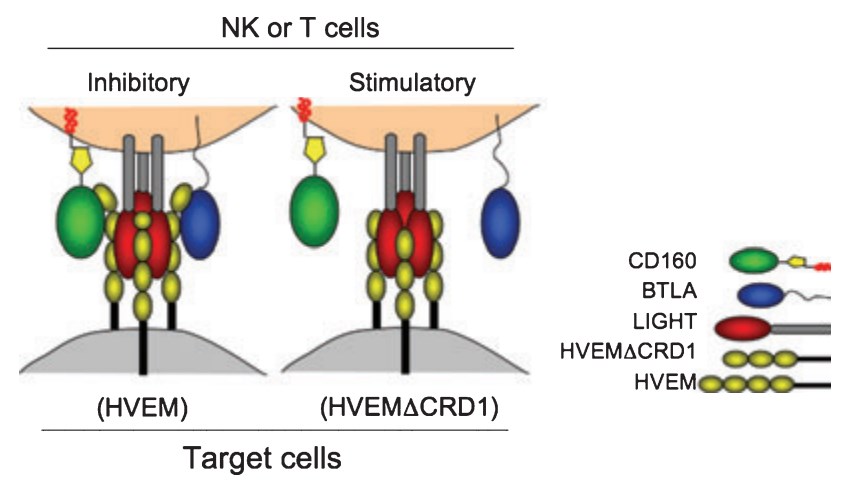CD160 is a glycosylphosphatidylinositol (GPI)-anchored Ig domain protein with homology to killer-cell immunoglobulin-like receptors. Herpes virus entry mediator (HVEM) is the only CD160 ligand identified by an expression cloning strategy. To learn more about CD160 involved pathway, please visit CD160 and HVEM pathway.
Table.1 Immune checkpoint CD160.
| Checkpoint receptor | Alternate name | Tissue distribution | Cellular expression | Ligand | Function of ligand-receptor interaction |
| CD160 | BY55 | High in the spleen, small intestine, and peripheral blood leukocytes; very low in brain, liver, heart, thymus, or other tissues | NK cells, NKT cells, IEL, 20-40% of CD8 T cells, 5% of CD4 T cells | HVEM | Binding to human HVEM with weaker affinity than BTLA. |
Human CD160 is first identified after an extensive screening of mAb raised against a human natural killer (NK) leukemia cell line. Unlike other MHC class I-dependent activating NK receptors, CD160 does not bear immunoreceptor tyrosine-based activation motifs. The Ig-like domain of CD160 contains six cysteine residues allowing the formation of multimers tightly linked by disulfide bonds. An alternative isoform of CD160 is also reported, which contains a cytoplasmic tail capable of activating the ERK1/2 signaling pathway. Both isoforms interact with ligands through the IgSF domain, including modest interactions with classical and non-classical MHC I molecules, and enhanced NK and T cell activity that promotes tumor angiogenesis.
CD160 is initially identified as a cell-surface antigen expressed on NK cells. It is also expressed mainly in other cytotoxic cells, such as CD8+ cells, a small subset of CD4+ cells, and all intraepithelial lymphocytes (IELs). The tissue distribution of CD160 in humans shows high expression in the spleen, peripheral blood lymphocytes, and small intestine (gut lymphocytes).
CD160 is a signaling molecule that interacts with HVEM and contributes to a wide range of immune responses, including T cell inhibition, natural killer cell activation, and mucosal immunity. CD160 expressed on CD4+ T cells is shown to interact with the HVEM resulting in suppressing CD4+ T cell proliferation and interferon-γ (IFN-γ) production. In contrast, in NK cells, CD160 binds weakly to MHC I, co-stimulates CD8+ T cell cytolytic activity, and activates NK cell cytotoxicity and cytokine production (IFN-c, TNFα, and IL-6). Furthermore, CD160 has been reported to be a marker for cytolytic or exhausted CD8+ T cells. Thus, CD160 can be both a co-activating and co-inhibitory receptor, depending on which receptor/ligand is operating in the context of neighboring interactions.
 Fig.1 CD160/HVEM. (Cai, 2009)
Fig.1 CD160/HVEM. (Cai, 2009)
The previous findings of CD160 as a co-inhibitory receptor in NKT cells shed light on the development of CD160/HVEM pathways as potential therapeutic targets for the treatment of many diseases. At present, most CD160 drugs are still in preclinical research.
Creative Biolabs is a drug discovery CRO that has over ten years of experience in immune checkpoint therapy development. Currently, a series of custom services for immune checkpoint CD160 is available at Creative Biolabs, including but not limited to:
Please feel free to contact us for more detailed information.
Reference
All listed customized services & products are for research use only, not intended for pharmaceutical, diagnostic, therapeutic, or any in vivo human use.
USA
Tel:
Fax:
Email:
Copyright © 2024 Creative Biolabs. All Rights Reserved.